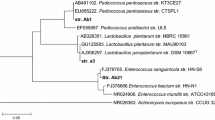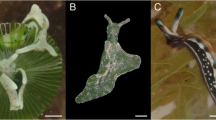Abstract
By applying a microinjection technique previously used in cell biology, a pH-sensitive dye, 2′,7′-bis(2-carboxyethyl)-5,6-carboxyfluorescein) (BCECF), was injected into the gut of the copepod Calanus helgolandicus to determine pH under a range of feeding conditions. The median gut pH of the fore- and hindguts of starved individuals was 6.86 and 7.19, respectively. This was a consistently lower pH than that observed in copepods feeding on either the diatom Thalassiosira weissflogii, the dinoflagellate Prorocentrum micans, or the coccolithophorid Emiliania huxleyi (Strain 92D), all of which had a median gut pH>7.0. In all treatments, the median pH of the foregut was more acidic than the median of the hindgut, implying that the foregut is the site of acid secretion. The results, which demonstrate pH values down to 6.11, are discussed in terms of coccolith dissolution, pigment degradation and digestive enzyme activity.
Similar content being viewed by others
References
Atkinson A, Ward P, Williams R, Poulet SA (1992) Diel vertical migration and feeding of copepods at an oceanic site near South Georgia. Mar Biol 113: 583–593
Bathmann UV, Noji TT, Voss M, Peinert R (1987) Copepod fecal pellets: abundance, sedimentation and content at a permanent station in the Norwegian Sea in May/June 1986. Mar Ecol Prog Ser 38: 45–51
Bramlette MN (1958) Significance of coccolithophores in calcium carbonate sedimentation. Bull geol Soc Am 69: 121–126
Dagg MJ, Frost BW, Walser WE Jr (1989) Copepod diel migration, feeding and the flux of phaeopigments. Limnol Oceanogr 34: 1062–1071
Dagg MJ, Wyman KD (1983) Natural ingestion rates of the copepods Neocalanus plumchrus and N. cristatus calculated from gut contents. Mar Ecol Prog Ser 13: 37–46
Downs JN, Lorenzen CJ (1985) Carbon: pheopigment ratios of zooplankton fecal pellets as an index of herbivorous feeding. Limnol Oceanogr 30: 1024–1036
Gieskes WW, Kraay GW (1986) Floristic and physiological differences between the shallow and the deep nanophytoplankton community in the euphotic zone of the open tropical Atlantic revealed by HPLC analysis of pigments. Mar Biol 91: 567–576
Harris RP (1994) Zooplankton grazing on the coccolithophore Emiliania huxleyi and its role in inorganic carbon flux. Mar Biol 119: 431–439
Head EJH, Harris LR (1992) Chlorophyll and carotenoid transformation and destruction by Calanus spp. grazing on diatoms. Mar Ecol Prog Ser 86: 229–238
Honjo J (1976) Coccoliths: production transportation and sedimentation. Mar Micropaleont 1: 65–79
Honjo J, Roman MR (1978) Marine copepod fecal pellets: production, preservation and sedimentation. J mar Res 36: 45–57
Jeffrey SW (1974) Profiles of photosynthetic pigments in the ocean using thin-layer chromatography. Mar Biol 26: 101–110
Maugle PD, Deshimaru O, Katayama T, Simpson KL (1982) Characteristics of amylase and protease of the shrimp Penaeus japonicus. Bull Jap Soc scient Fish 48: 1753–1757
Mayzaud P (1986) Digestive enzymes and their relation to nutrition. In: Corner EDS, O'Hara SCM (eds) The biological chemistry of marine copepods. Clarendon Press, Oxford, pp 226–259
Mayzaud P, Mayzaud O (1981) Kinetic properties of digestive carbohydrases and proteases of zooplankton. Can J Fish aquat Sciences 38: 535–543
McClatchie S (1986) Time-series feeding rates of the euphausid Thysanoessa raschii in temporally patchy food environments. Limnol Oceanogr 31: 469–477
Nimer NA, Brownlee C, Merrett MJ (1994) Carbon dioxide availability, intracellular pH and growth rate of the coccolithophore Emiliania huxleyi. Mar Ecol Prog Ser 109: 257–262
Okada H, McIntyre A (1979) Seasonal distribution of modern coccolithophores in the Western North Atlantic Ocean. Mar Biol 54: 319–328
Penry DL, Frost BW (1991) Chlorophyll a degradation by Calanus pacificus: dependence on ingestion rate and digestive acclimation to food sources. Limnol Oceanogr 36: 147–159
Pilskaln CH (1987) The fecal pellet fraction of biogeochemical particle fluxes to the deep sea. Global biogeochem Cycles 1: 31–48
Shuman FR, Lorenzen CJ (1975) Quantitative degradation of chlorophyll by a marine herbivore. Limnol Oceanogr 20: 580–586
Tande KS, Slagstad D (1982) Ecological investigations on the zooplankton community of Balsfjorden, northern Norway. Seasonal and short-time variations in enzyme activity in copepod stage V and V1 males and female Calanus finmarchicus (Gunnerus). Sarsia 67: 63–68
Van Wheel PB (1970) Digestion in Crustacea. In: Florkin M, Scheer BT (eds) Chemical zoology. Academic Press, New York, London, pp 97–115
Wang R, Conover RJ (1986) Dynamics of gut pigment in the copepod Temora longicornis and the determination of in situ grazing rates. Limnol Oceanogr 31: 867–877
Author information
Authors and Affiliations
Additional information
Communicated by J. Mauchline, Oban
Rights and permissions
About this article
Cite this article
Pond, D.W., Harris, R.P. & Brownlee, C. A microinjection technique using a pH-sensitive dye to determine the gut pH of Calanus helgolandicus . Marine Biology 123, 75–79 (1995). https://doi.org/10.1007/BF00350325
Received:
Accepted:
Issue Date:
DOI: https://doi.org/10.1007/BF00350325




